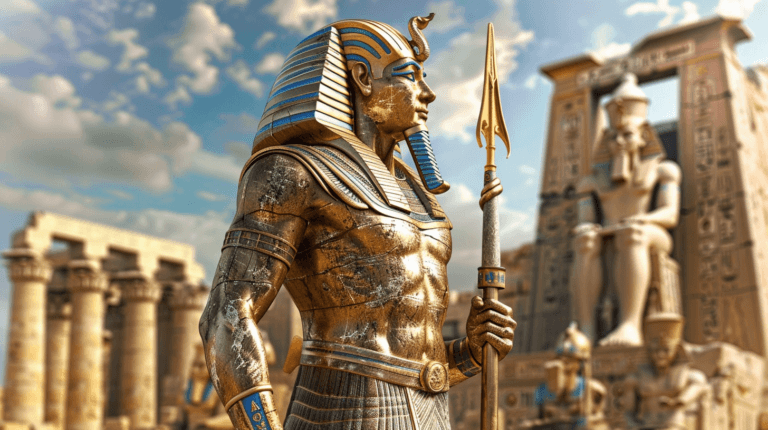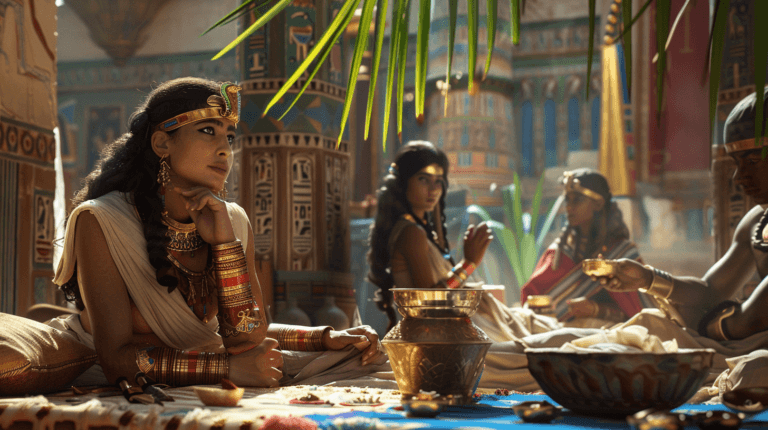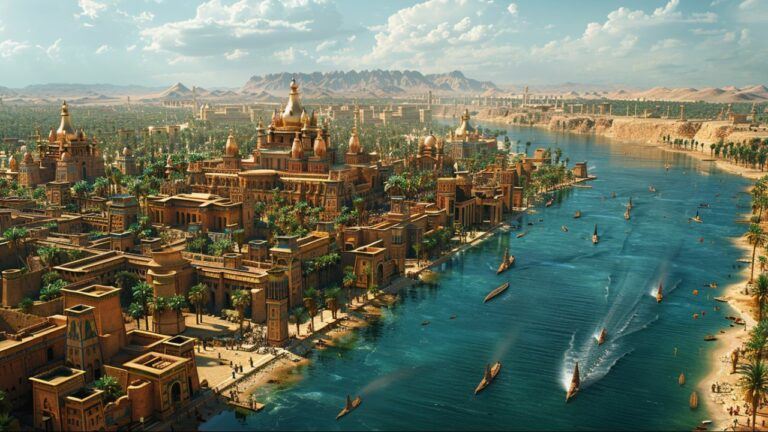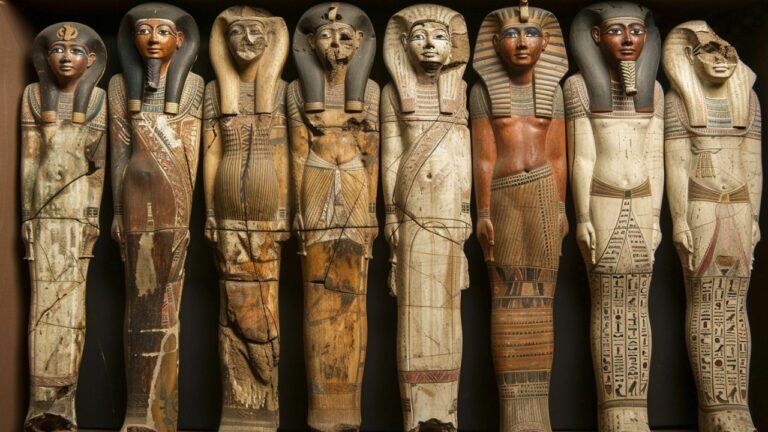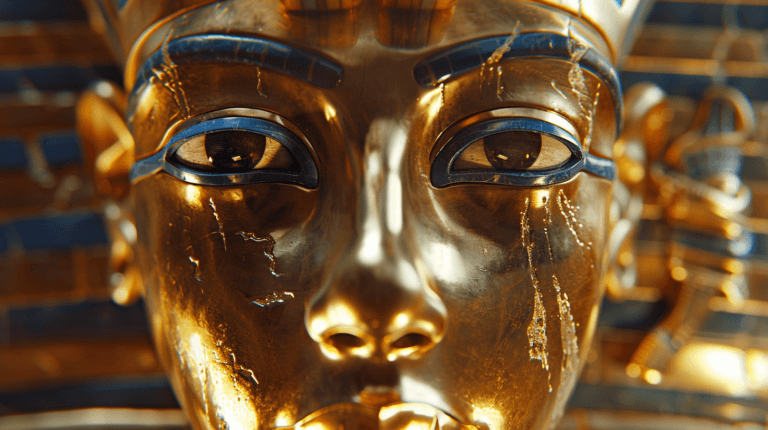Fashion in Ancient Egypt: Discover Timeless Elegance
Fashion in Ancient Egypt was not only a form of self-expression but also a reflection of societal norms and religious beliefs. Clothes were made with an emphasis on both aesthetics and comfort, reflecting the climatic conditions of the region.
Ancient Egyptians are renowned for their timeless fashion sense, which managed to blend practicality with ornamentation beautifully. As recognized in the art and artifacts left behind, the variation of clothing between social classes was slight; yet subtle differences in materials and accessories indicated one’s status.

My understanding of the ancient Egyptians’ approach to fashion uncovers a culture that valued cleanliness and simplicity. Linen was the fabric of choice due to its lightweight and cooling properties, ideal for a hot climate.
Their garments were typically white, the natural color of linen, although dyed fabrics were also used. The styles were relatively consistent over thousands of years, with men and women wearing similar styles of clothing. However, jewelry and other adornments would often be used to express individual wealth and rank, indicating an intricate relationship between fashion and social hierarchy.
Key Takeaways
- Ancient Egyptian fashion was characterized by simplicity and functionality, designed for comfort in a hot climate.
- Linen was the predominant fabric used, valued for its lightness and breathability.
- Fashion served as a social indicator, differentiating the elite from the common folk through the use of jewelry and adornments.
Historical Context and Fashion in Ancient Egypt Evolution

Fashion in Ancient Egypt wasn’t just about style; it reflected social status, religious practices, and the climate of the Nile River Valley. Changes in dress can be traced through the different Kingdom periods, illustrating the evolution of Egyptian society.
Early Dynastic Period and Old Kingdom
During the Early Dynastic Period (c. 3150 – c. 2613 BCE), I see simple yet functional clothing as the norm. Both men and women of the lower class typically wore a knee-length kilt. This kind of attire likely favored materials like cotton, linen, or byssus, known for its coolness in a hot climate.
Images from this time depict these garments as plain, probably white or light in color, secured around the waist with a belt that could be fashioned from various materials such as cloth, papyrus rope, or leather. Fashion & Dress in Ancient Egypt tells me that simplicity was key in this era, possibly due to practicality and the resources available.
Middle Kingdom to New Kingdom
Moving into the Middle Kingdom and onto the New Kingdom, fashion takes on more complexity and displays greater sophistication. The transition reflects growing wealth and cultural exchange. By the time we reach the New Kingdom (c. 1550 – c. 1077 BCE), the opulence and intricacy in dress is noticeable; the society’s affluence has left its mark on the fashion of the time.
Linen remained the preferred fabric due to its light and airy nature, suited for Egypt’s weather, but the styles became more elaborate. Garments like the kalasiris, a type of tunic worn by women, evolved into more form-fitting and intricate designs, sometimes complemented with pleats or beads, demonstrating the innovation in dress during this period. Exploring the Fashion Evolution in Ancient Egypt covers the journey of Egyptian attire from its simple beginnings to its luxurious transformations.
Clothing Materials and Design

When I dive into the world of Ancient Egyptian fashion, I can’t help but be fascinated by their textile ingenuity and the vibrant colors that symbolized various aspects of their culture. It’s clear that they were experts at utilizing the resources at their disposal to create attire that was both functional and expressive.
Common Fabrics
Linen was the fabric of choice in Ancient Egypt. I’m talking about a textile made from the flax plant, which was plentiful along the Nile. The Egyptians were masters at spinning this plant fiber into fine threads and weaving it into lightweight, breathable garments that were perfect for the hot and sunny climate. Linen wasn’t just popular because it was cool; it symbolized purity and cleanliness, which were big deals back then.
Cotton was around, but it wasn’t as common since it came into use later on. Wool was also used, especially for ceremonial garments or by the elites, but it wasn’t as prevalent due to religious restrictions; priests couldn’t enter temples wearing wool.
Color Significance and Style
Colors in Ancient Egyptian clothing weren’t just for looks; they had meaning behind them. White was the most popular, not just for its reflective qualities but also because it was associated with purity and sacredness. But they didn’t shy away from bold hues either. Reds, blues, and yellows made frequent appearances and were often derived from natural dyes.
Their clothing styles were pretty straightforward. Men generally wore knee-length kilts, while women had sheath dresses that could get rather form-fitting. However, what I find cool is that fashion wasn’t stagnant; it evolved. The length and complexity of garments would change over time, often reflecting one’s social status. The rich could afford to wear clothing adorned with jewels and intricate pleating, indicating their higher position in society.
Fashionable Accoutrements

When I think about how the Ancient Egyptians dressed up, it’s not just the clothes that grab my attention. Their fashionable accessories were a big deal, revealing status and enhancing beauty in heaps.
Jewelry and Status Symbols
For the ancient Egyptians, jewelry wasn’t just for show; it was a display of wealth and status. Pieces like bracelets and anklets were common, often crafted from gold or silver and inlaid with semi-precious stones or colored glass. Royals really upped the ante, with dazzling collections of jewels.
- Amulets held special significance, believed to protect the wearer, and were worn by all classes.
Footwear and Cosmetics
Believe it or not, sandals in Ancient Egypt were more than just practical; they were a status symbol. Most were made from papyrus or palm, though the elite might show off with versions in leather. As for cosmetics, both men and women applied kohl to their eyes, usually from galena and malachite – not just for fashion but also for health benefits, like reducing glare from the sun.
- Makeup: Essential, with a necessary dash of practicality.
Wigs and Hair Accessories
Your hair might be a mess without modern conveniences, but ancient Egyptians had wigs to deal with that. Made from human hair or sheep’s wool, these hair masterpieces were decorated with gold tubes and faience beads. Upper-class individuals often had a collection, serving as the ultimate hair accessories and a way to strut their wealth.
- Everyone used them – they kept you cool and made you look hot.
Societal Influence on Dress

In ancient Egypt, clothing was a direct reflection of social status and religious identity. From the refined ensembles of the upper class to the symbolic outfits of the priesthood, each garment had its weight in society.
Upper-Class Elegance
As a member of the Egyptian upper class, attire was luxurious and elaborately designed to display wealth and status. Linen was the fabric of choice due to its breathability and the comfort it provided in the hot Egyptian climate. People favored fine, pleated linen that was at times almost transparent, signifying the quality and the painstaking labor that went into its production. Adornments like jewelry, often inlaid with precious stones and metals, would be liberally used to see further to represent stature in life and in the afterlife.
Priests and Religious Garb
A role as a priest in ancient Egypt was not just a profession—it was a lifelong dedication to the gods. Priests wore clothing that reflected a sacred position within society. Simple white linen robes signified my purity and dedication, while specific colors and sacred symbols, such as the ankh, were incorporated to venerate the gods they served. The act of adorning these garments was ritualistic, and every piece signified a facet of devotion to the divine and the responsibilities carried to maintain the balance between daily life and the afterlife.
Frequently Asked Questions – Fashion in Ancient Egypt

In this section, I explore some of the most common curiosities about the sartorial elegance of fashion in ancient Egypt, from the materials they used to the influence of their style on modern fashion.
What materials were used to make clothing in ancient Egypt?
I’ve learned that the favorite fabric for clothing in ancient Egypt was linen, crafted from flax plants. It was popular due to its breathability and suitability for the hot climate.
How did social status affect clothing styles in ancient Egypt?
Social status played a significant role in ancient Egyptian attire. The higher the status, the more elaborate and decorated the outfits became, featuring pleats, beads, and gold threads. Symbols of wealth and power, like intricate jewelry, often accompanied these garments.
Can you describe typical jewelry worn in ancient Egypt?
Typical jewelry in ancient Egypt included bracelets, necklaces, and earrings made of gold, silver, and precious stones. Items like the Ankh symbol and scarab beetles were commonly incorporated.
What were the common clothing styles for men in ancient Egypt?
Men typically wore a simple kilt-like garment, tied or belted at the waist, that varied in length depending on the era. Officials and pharaohs, however, donned more elaborate and decorated versions.
How did ancient Egyptian fashion evolve over time?
Fashion in ancient Egypt gradually evolved from simple wraparound garments to more tailored and pleated clothing. Over the dynasties, the complexity of designs and the use of colors, particularly in the attire of the elite, became more pronounced.
In what ways has ancient Egyptian fashion influenced modern styles?
Ancient Egyptian fashion has inspired modern styles with its distinct pleated skirts and ornate jewelry. Designers often borrow the clean lines, draping techniques, and even the symbolic imagery, infusing contemporary fashion with a touch of antiquity.


